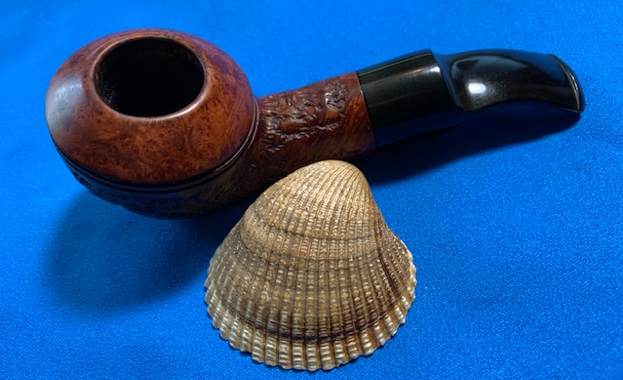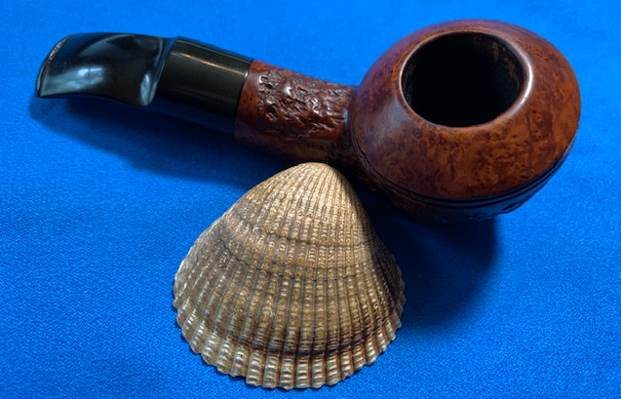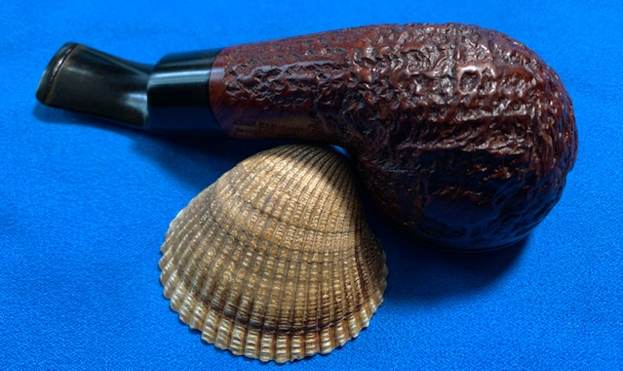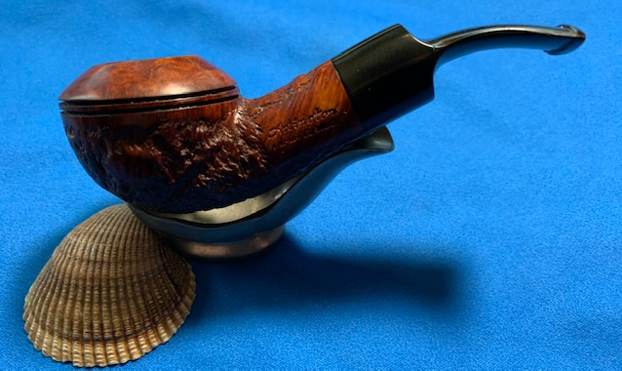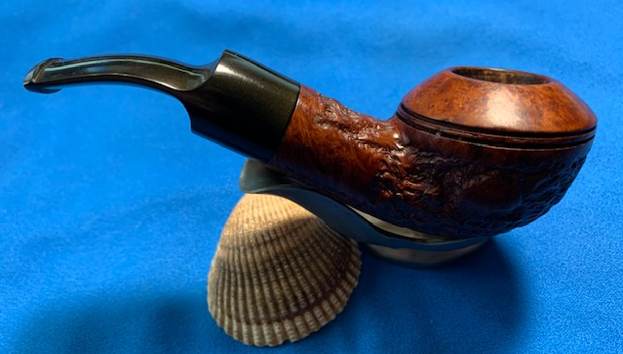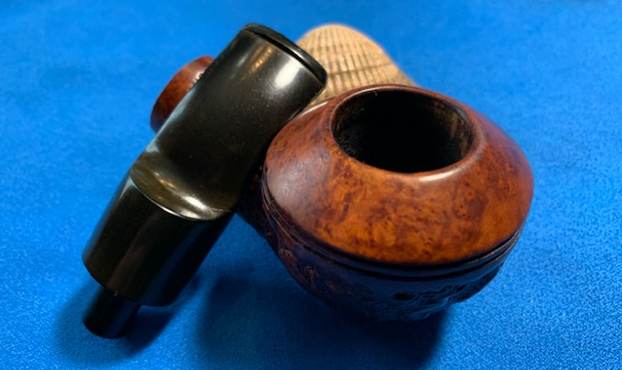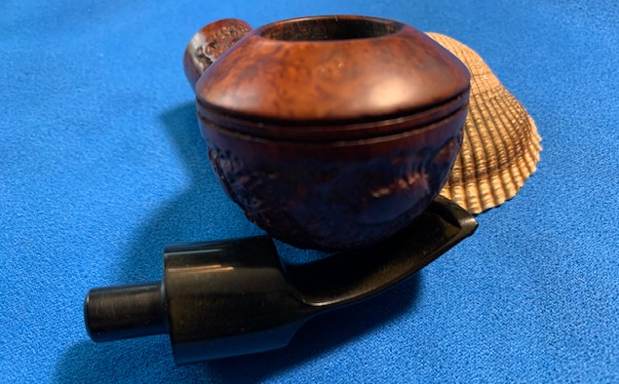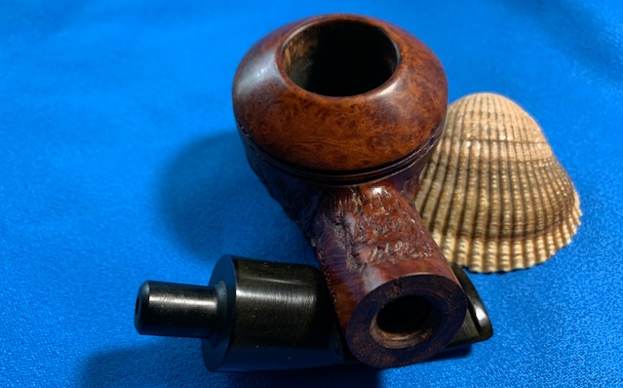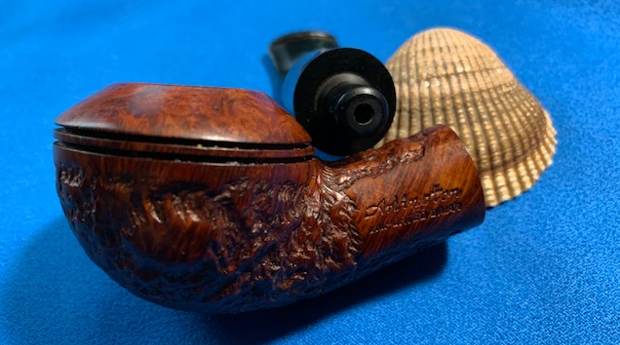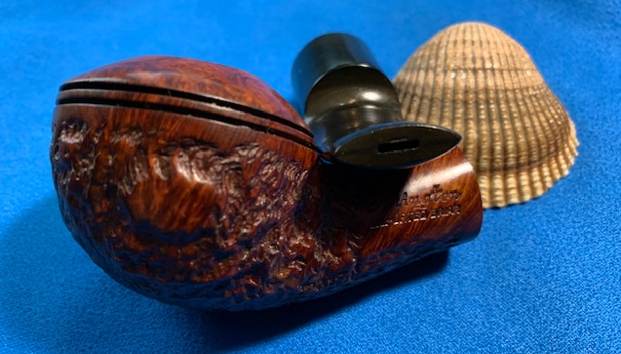Blog by Steve Laug
The next pipe on the work table is another pipe that has been here for over 5 years. Sad that there are some that have sat this long or longer before I got to them. But on the other hand I get to look through my boxes and pick out what turns my crank at the moment. This one was a nice looking bent Rhodesian with interesting rustication patterns. We picked it up back in May, 2017 off EBay from a seller in Lewisburg, Ohio, USA. It is stamped on the left side of the shank and reads Arlington in script [over] Imported Briar. The rustication is rugged but has a smooth spot on each side of the bowl, a panel on the front and each side of the shank and a smooth band around the shank end. It is dirty but is quite nice with the reds and browns of the briar and the black vulcanite stem. The pipe was another one that had obviously been someone’s favourite and must have been a grand smoker. The finish is very dirty with dust in the rustication. The bowl is heavily caked with a thick lava overflow on the rim top. The inner edge was also thickly caked with lava. The stem is lightly oxidized, calcified and had some tooth chatter on the top and underside ahead of the button. The pipe showed a lot of promise but it was a mess. Jeff took pictures of the pipe before he did his clean up work.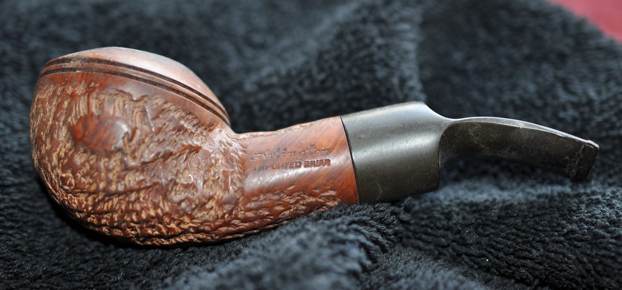
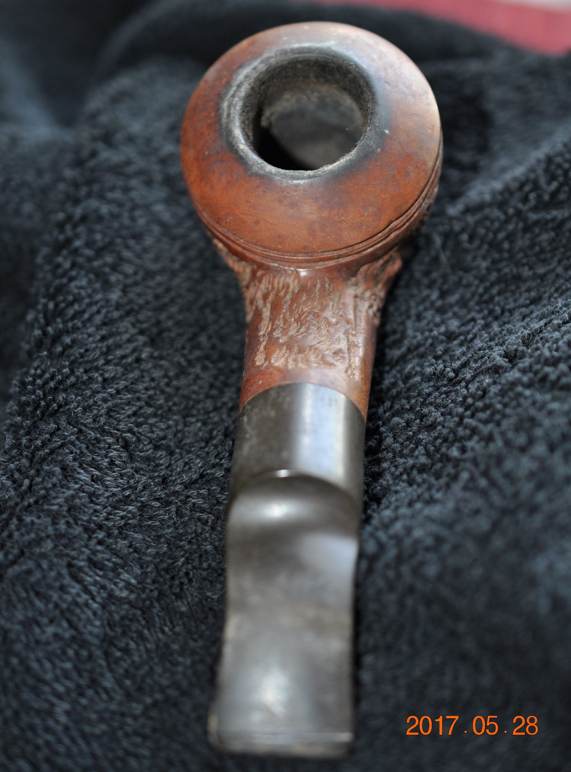 He took photos of the rim top and bowl as well as the stem surfaces to show the condition of the well smoked pipe. You can see the thick cake in the bowl and the heavy lava on the inner edge and rim top. The stem was oxidized, calcified and had tooth chatter on both sides ahead of the button.
He took photos of the rim top and bowl as well as the stem surfaces to show the condition of the well smoked pipe. You can see the thick cake in the bowl and the heavy lava on the inner edge and rim top. The stem was oxidized, calcified and had tooth chatter on both sides ahead of the button.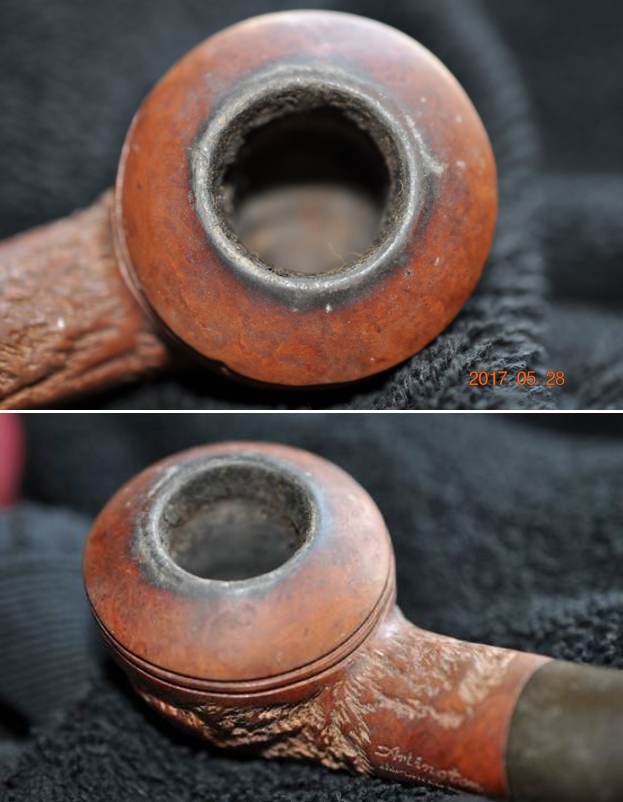
 He removed the stem from the shank and revealed a very tarry and dirty stinger apparatus that in the tenon.
He removed the stem from the shank and revealed a very tarry and dirty stinger apparatus that in the tenon. Jeff took some photos of the heel of the bowl and the side to give a sense of the rustication style around this pipe.
Jeff took some photos of the heel of the bowl and the side to give a sense of the rustication style around this pipe. 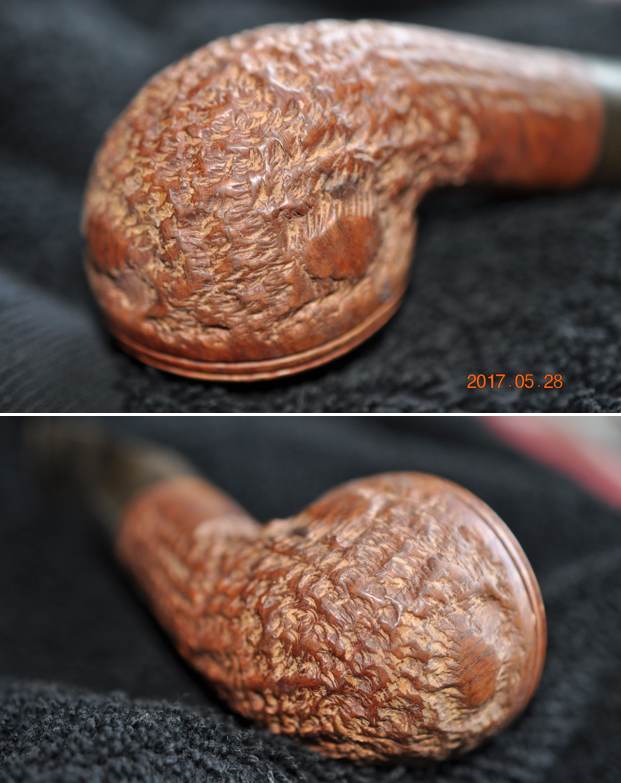
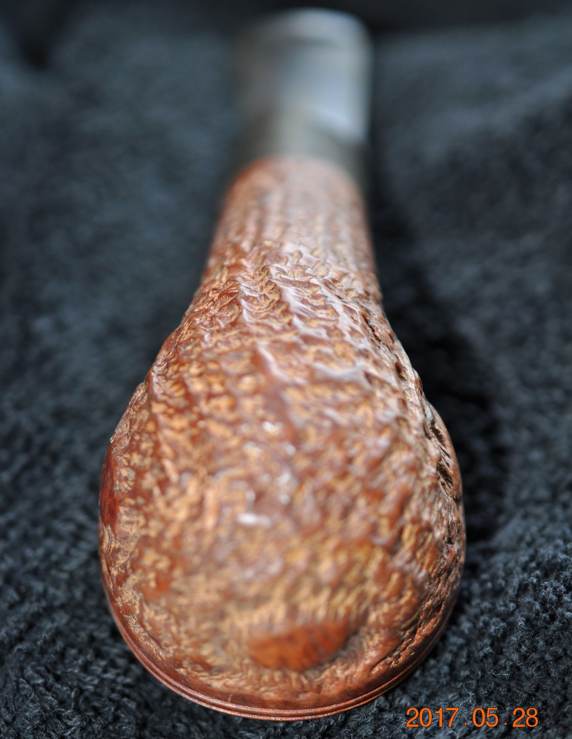 He captured the stamping on the underside of the shank. It is readable as noted above.
He captured the stamping on the underside of the shank. It is readable as noted above. 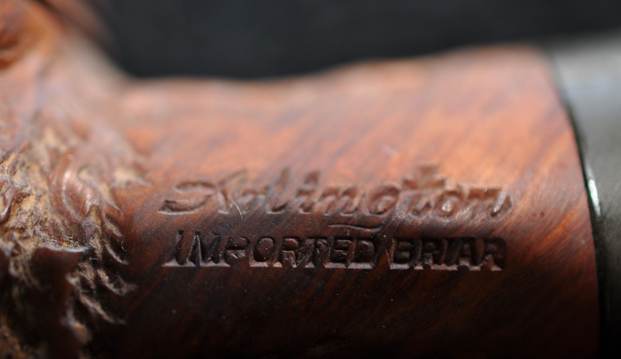 I turned to Pipephil to get a quick overview of the background information on the Arlington brand (http://pipephil.eu/logos/en/logo-a7.html). The side bar stated that it was a brand of the Arlington Briar Pipe Corp. I have included a screen capture of the pertinent information below.
I turned to Pipephil to get a quick overview of the background information on the Arlington brand (http://pipephil.eu/logos/en/logo-a7.html). The side bar stated that it was a brand of the Arlington Briar Pipe Corp. I have included a screen capture of the pertinent information below. I turned to Pipedia for more information (https://pipedia.org/wiki/Arlington). I quote the article below.
I turned to Pipedia for more information (https://pipedia.org/wiki/Arlington). I quote the article below.
Arlington Briar Pipes Corporation was founded in 1919 in Brooklyn, New York, and produced the Arlington, Briarlee, Firethorn, Kimberly, Krona and Olde London brands among dozens of others, primarily acting as a subcontractor making pipes to be sold under other brand names. Among others, in the 1950’s, Arlington turned pipes for the famed Wilke Pipe Shop in New York City. The corporation was dissolved by the State of New York as inactive on December 6, 1978. Arlington Briar Pipe Corporation, located at 200 Kosciusko Street, Brooklyn, New York, registered only a single brand trademark, the Arlington brand, the trademark for which was applied for on November 13, 1962 and granted on February 25, 1964. Jack Kaye, of Arlington Briar, was also granted a patent for a combined mirror and stand in 1967.
According to José Manuel Lopes, “North American brand that belonged to Arlington Briar Pipes Corp., Brooklyn, New York, founded in 1919. In the 1940s, Ludwig Rosenberger gave the company new life, and it continued until the 70s. His son, Mel Rosenberger, has recently launched the DiMonte brand. Jack Uhle was also linked to Arlington.” Arlington, as far as known, mainly operated as a sub-contractor for other brands. The Jobey pipes are said to be made by Arlington at an unknown point of time. Arlington’s own pipes are seldom seen.
The article also included the following photo from an RTDA catalog. It is a great addition to the information above. Now it was time to look at it up close and personal. Jeff had done an amazing job in removing all of the cake and the lava on the rim top. He had reamed the bowl with a PipNet Pipe Reamer and cleaned up the remnants with a Savinelli Fitsall Pipe Knife. He took the cake back to bare briar so we could check the walls for damage. He scrubbed the exterior of the bowl with Murphy’s Oil Soap and a tooth brush to remove the grime on the bowl and rim and was able to remove the lava and dirt. He cleaned out the interior of the bowl and shank with pipe cleaners, cotton swabs and alcohol until they came out clean. He cleaned the stem with Soft Scrub to remove the grime on the exterior. He cleaned out the airway with alcohol, cotton swabs and pipe cleaners. I took some photos of the pipe before I started my work on it today.
Now it was time to look at it up close and personal. Jeff had done an amazing job in removing all of the cake and the lava on the rim top. He had reamed the bowl with a PipNet Pipe Reamer and cleaned up the remnants with a Savinelli Fitsall Pipe Knife. He took the cake back to bare briar so we could check the walls for damage. He scrubbed the exterior of the bowl with Murphy’s Oil Soap and a tooth brush to remove the grime on the bowl and rim and was able to remove the lava and dirt. He cleaned out the interior of the bowl and shank with pipe cleaners, cotton swabs and alcohol until they came out clean. He cleaned the stem with Soft Scrub to remove the grime on the exterior. He cleaned out the airway with alcohol, cotton swabs and pipe cleaners. I took some photos of the pipe before I started my work on it today. 
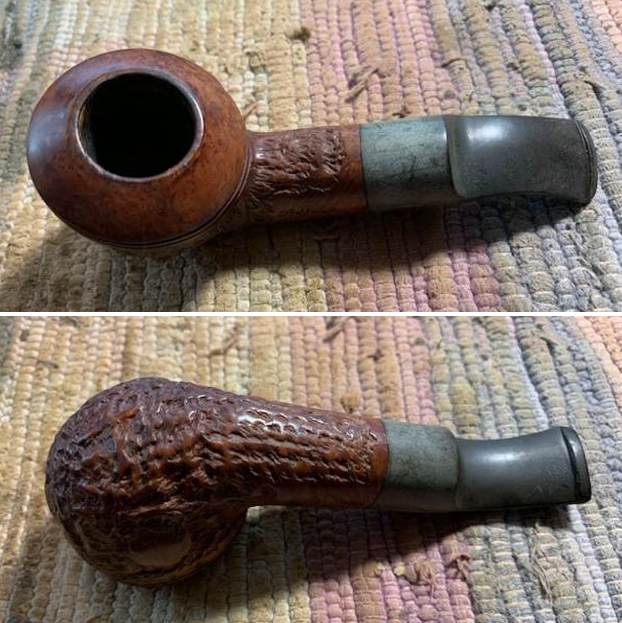 I took a close up photo of the cleaned up rim top. The rim top and the inner edge look good. The bowl is clean and the walls are undamaged. The stem looks good with light tooth chatter along the top and underside ahead of the button.
I took a close up photo of the cleaned up rim top. The rim top and the inner edge look good. The bowl is clean and the walls are undamaged. The stem looks good with light tooth chatter along the top and underside ahead of the button. I took a photo of the stamping on the shank side. It is clear and readable as noted above.
I took a photo of the stamping on the shank side. It is clear and readable as noted above.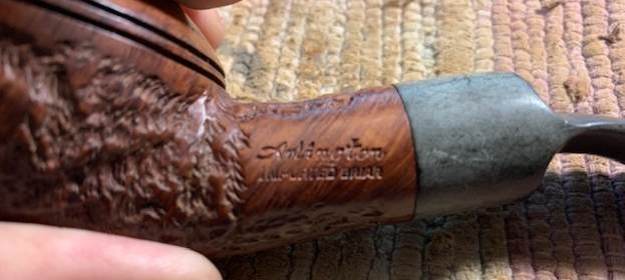 I took the stem off the pipe and took a photo. The Rhodesian is a chunky looking pipe with nice lines.
I took the stem off the pipe and took a photo. The Rhodesian is a chunky looking pipe with nice lines.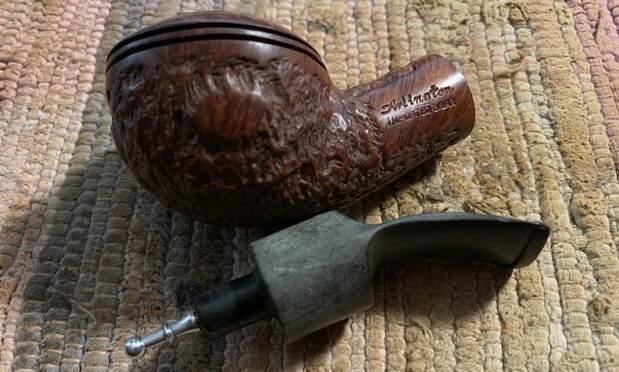 I started my work on the pipe with a simple first step. I touched up the stain on the inner edge of the rim with an Oak Stain pen. It matched well and would work very well once I polished the rest of the rim top. I chose to do this at this stage as the polishing would served to blend it in and make it unnoticeable.
I started my work on the pipe with a simple first step. I touched up the stain on the inner edge of the rim with an Oak Stain pen. It matched well and would work very well once I polished the rest of the rim top. I chose to do this at this stage as the polishing would served to blend it in and make it unnoticeable. I polished the smooth rim top and areas on the bowl and shank with micromesh sanding pads – dry sanding with 1500-12000 grit pads. After each pad I wiped the bowl down with a damp cloth to remove the sanding debris. It really took on a shine by the last three sanding pads.
I polished the smooth rim top and areas on the bowl and shank with micromesh sanding pads – dry sanding with 1500-12000 grit pads. After each pad I wiped the bowl down with a damp cloth to remove the sanding debris. It really took on a shine by the last three sanding pads. 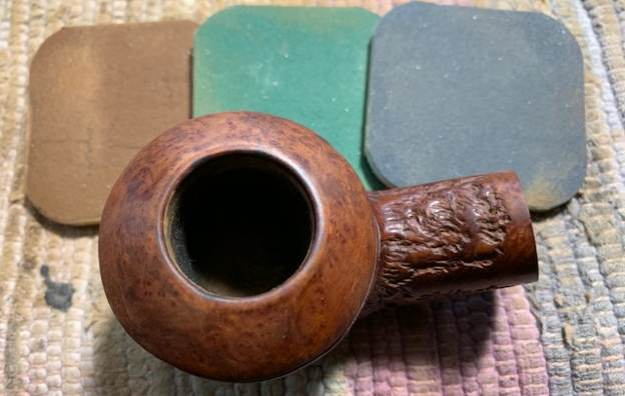
 I rubbed the bowl down with Before & After Restoration Balm. I worked it into the surface of the briar with my fingertips where it works to clean, restore and preserve the briar. I let it do its magic for 15 minutes then buffed it off with a cotton cloth. The pipe looks incredibly good at this point in the process.
I rubbed the bowl down with Before & After Restoration Balm. I worked it into the surface of the briar with my fingertips where it works to clean, restore and preserve the briar. I let it do its magic for 15 minutes then buffed it off with a cotton cloth. The pipe looks incredibly good at this point in the process.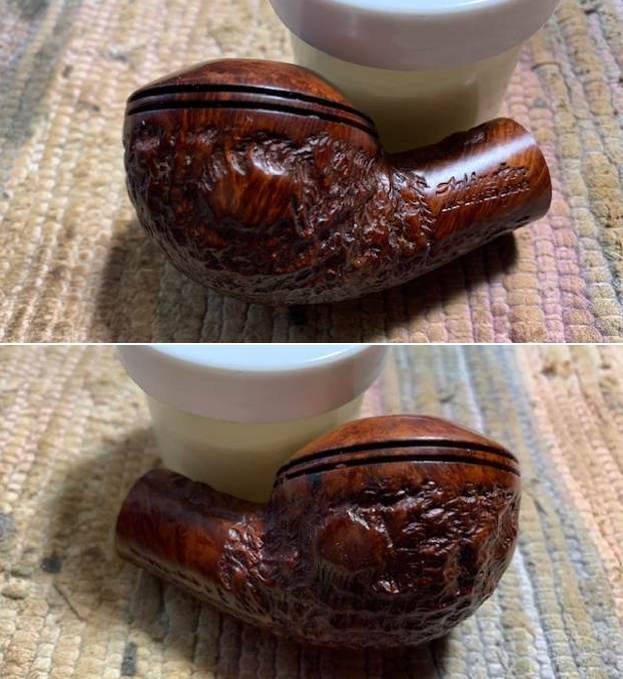
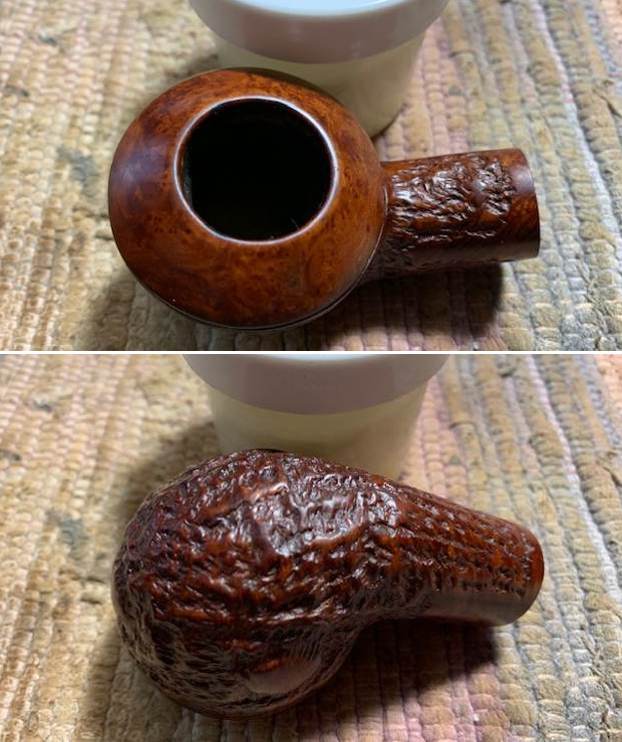
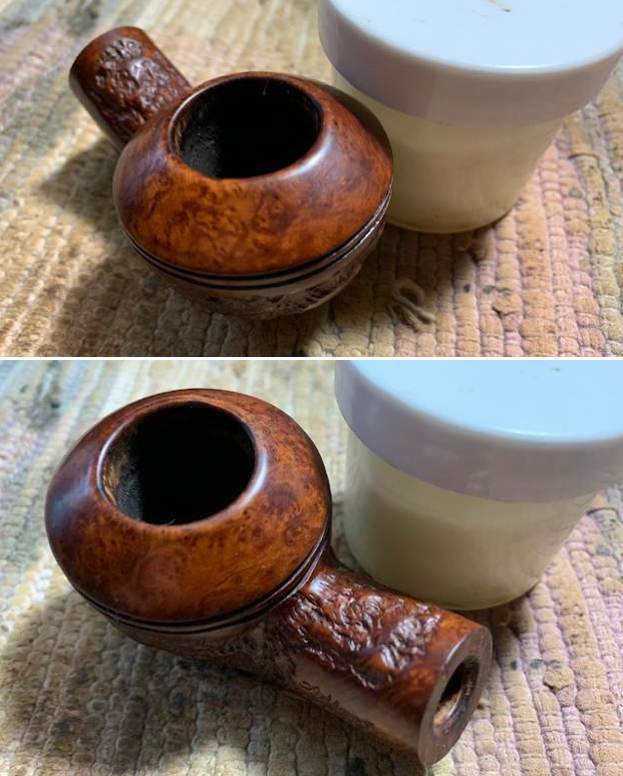 I set aside the bowl and turned my attention to the stem. I heated the tenon with the flame of a lighter and was able to pull it out quite easily. I double checked the cleaning on it now that it was out of the tenon and found that it was very clean.
I set aside the bowl and turned my attention to the stem. I heated the tenon with the flame of a lighter and was able to pull it out quite easily. I double checked the cleaning on it now that it was out of the tenon and found that it was very clean.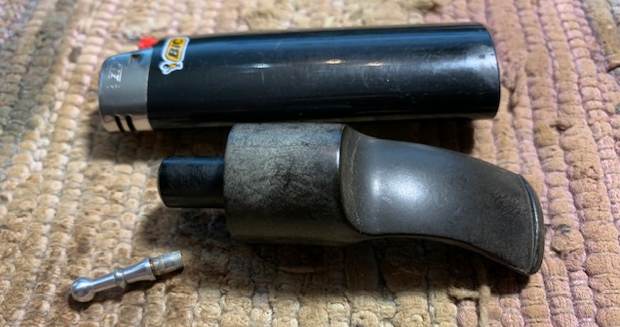 I scrubbed the surface of the stem with Soft Scrub cleanser to remove the oxidation on the surface. Once I was finished it looked significantly better.
I scrubbed the surface of the stem with Soft Scrub cleanser to remove the oxidation on the surface. Once I was finished it looked significantly better.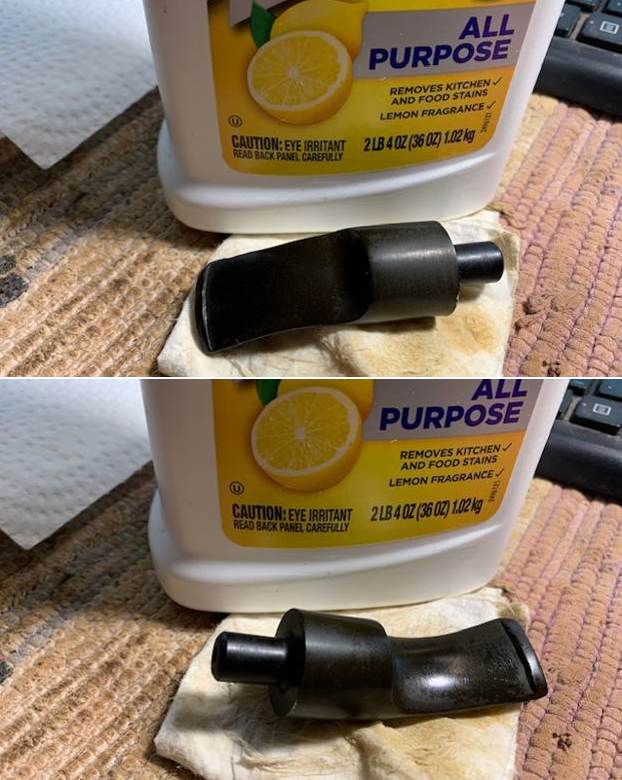 I sanded the tooth chatter and remnants of oxidation on both sides with 220 grit sandpaper and started the polishing with 400 grit wet dry sandpaper. Each step took it closer to the finished look.
I sanded the tooth chatter and remnants of oxidation on both sides with 220 grit sandpaper and started the polishing with 400 grit wet dry sandpaper. Each step took it closer to the finished look.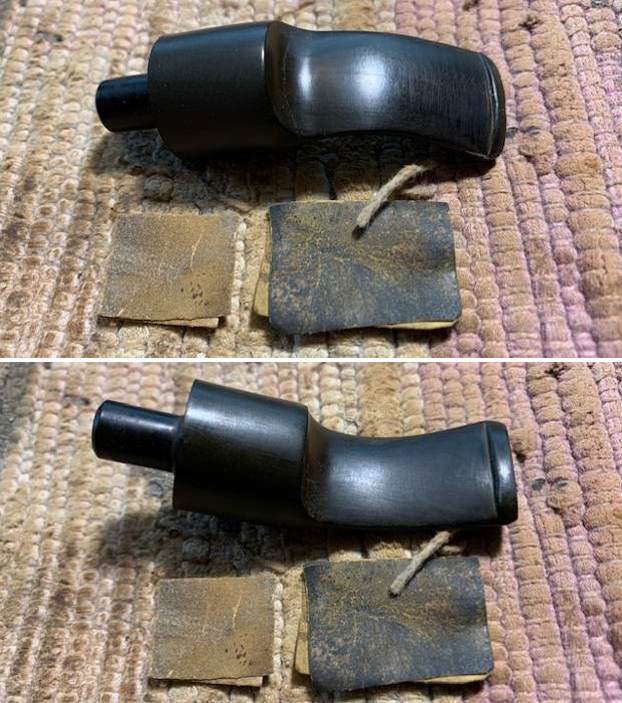 I continued to polish the stem with micromesh sanding pads – wet sanding with 1500-12000 grit sanding pads. I wiped it down after each sanding pad with Obsidian Oil. I polished it further with Before & After Stem Polish – both Fine and Extra Fine. I gave it a final coat of Obsidian Oil and set it aside to cure.
I continued to polish the stem with micromesh sanding pads – wet sanding with 1500-12000 grit sanding pads. I wiped it down after each sanding pad with Obsidian Oil. I polished it further with Before & After Stem Polish – both Fine and Extra Fine. I gave it a final coat of Obsidian Oil and set it aside to cure.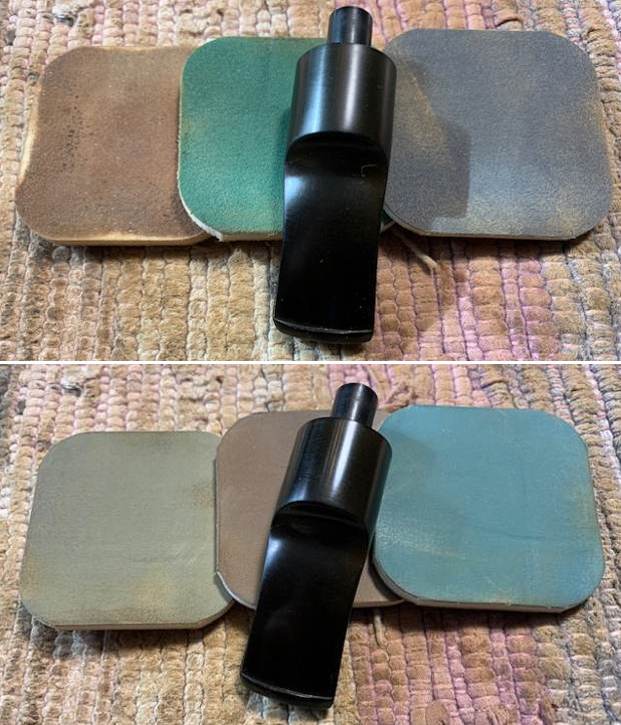
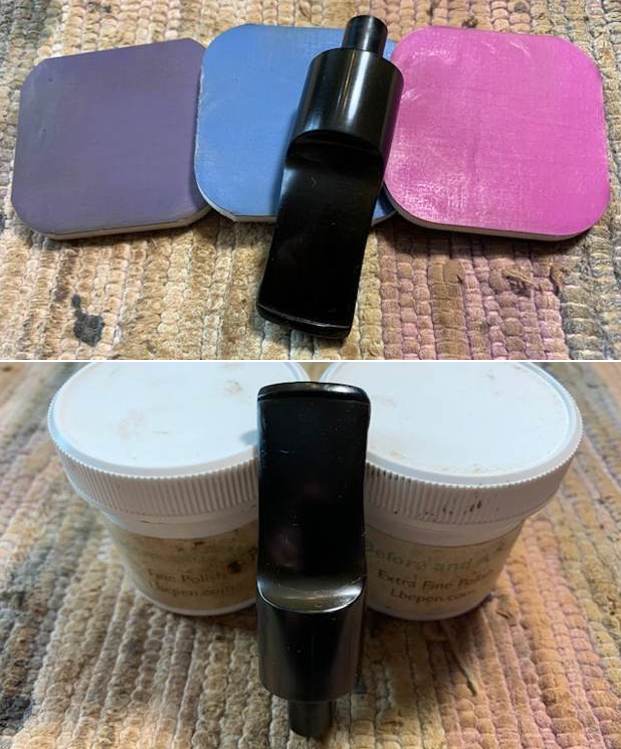 I am excited to finish this Arlington Imported Briar Rhodesian. I put the pipe back together and buffed it with Blue Diamond on the buffing wheel. I gave the bowl multiple coats of Conservator’s Wax and the stem multiple coats of carnauba wax. I buffed the pipe with a clean buffing pad to raise the shine and then by hand with a microfibre cloth to deepen it. It is fun to see what the polished bowl looks like with beautiful grain on the smooth portions and the rustication depths all around it. The polished grain on the pipe looks great with the black vulcanite stem. This Arlington Rhodesian is great looking and the pipe feels great in my hand. It is light and well balanced. Have a look at it with the photos below. The dimensions are Length: 5 inches, Height: 1 ½ inches, Outside diameter of the bowl: 1 ¾ inches, Chamber diameter: 7/8 of an inch. The weight of the pipe is 54 grams/1.90 ounces. It turned out to be a beautiful pipe. I will soon be putting it on the rebornpipes store in the American Pipemakers Section. If you are interested in adding it to your collection let me know. Remember we are the next in a long line of pipe men and women who will carry on the trust of our pipes until we pass them on to the next trustee. Thanks for your time reading this blog.
I am excited to finish this Arlington Imported Briar Rhodesian. I put the pipe back together and buffed it with Blue Diamond on the buffing wheel. I gave the bowl multiple coats of Conservator’s Wax and the stem multiple coats of carnauba wax. I buffed the pipe with a clean buffing pad to raise the shine and then by hand with a microfibre cloth to deepen it. It is fun to see what the polished bowl looks like with beautiful grain on the smooth portions and the rustication depths all around it. The polished grain on the pipe looks great with the black vulcanite stem. This Arlington Rhodesian is great looking and the pipe feels great in my hand. It is light and well balanced. Have a look at it with the photos below. The dimensions are Length: 5 inches, Height: 1 ½ inches, Outside diameter of the bowl: 1 ¾ inches, Chamber diameter: 7/8 of an inch. The weight of the pipe is 54 grams/1.90 ounces. It turned out to be a beautiful pipe. I will soon be putting it on the rebornpipes store in the American Pipemakers Section. If you are interested in adding it to your collection let me know. Remember we are the next in a long line of pipe men and women who will carry on the trust of our pipes until we pass them on to the next trustee. Thanks for your time reading this blog.

